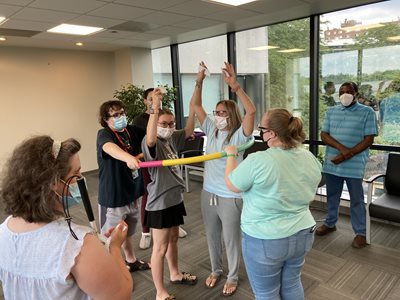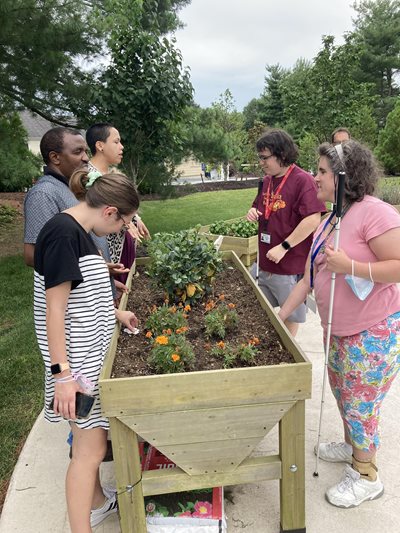 Innovation and creativity are at the core of what the Teacher of the Visually Impaired (TVI) program teaches, and the Numeracy and Science course is the perfect example of that. The course is offered during the summer to TVI students within the Blindness and Low Vision Studies (BLVS) program and educates on how to teach science and math curriculum to students with visual impairments.
Innovation and creativity are at the core of what the Teacher of the Visually Impaired (TVI) program teaches, and the Numeracy and Science course is the perfect example of that. The course is offered during the summer to TVI students within the Blindness and Low Vision Studies (BLVS) program and educates on how to teach science and math curriculum to students with visual impairments.
“Inclusive education of students with visual impairments often requires a multisensory approach. That is particularly important in the areas of math and science, in which traditional teaching relies mostly on visual information that may not be available to students who are blind or have low vision,” said Emily Vasile, MAT, TVI, MS ‘16, CLVT. “Lack of appropriate interventions can lead to significant disadvantages for these students’ learning experiences, lower expectations from their teachers, and eventually limit prospects of future education or employment. Salus’ TVI program addresses these challenges and prepares graduates to make math and science accessible to all students, regardless of their level of functional vision.”
In a recent two-part course activity, TVI students tested their innovation and problem-solving skills to learn about incorporating different elements of the expanded core curriculum into their lessons. The expanded core curriculum (ECC) was created for students with visual impairments and includes nine focus areas: compensatory access, independent living skills, career exploration, orientation & mobility, assistive technology, self-determination, recreation and leisure, social interaction, and sensory efficiency.
 In the first activity, students created a human atom based on an element from the periodic table. “Students all received three notecards, each brailled with either proton, neutron, or electron. Using a hula hoop as the cell of the atom, they had to work together to figure out how to make specific elements on the periodic table,” said Vasile. “Once they began to understand the concept of the activity we went back to the classroom and students used tactile materials to create their own tactile graphic of an atom.”
In the first activity, students created a human atom based on an element from the periodic table. “Students all received three notecards, each brailled with either proton, neutron, or electron. Using a hula hoop as the cell of the atom, they had to work together to figure out how to make specific elements on the periodic table,” said Vasile. “Once they began to understand the concept of the activity we went back to the classroom and students used tactile materials to create their own tactile graphic of an atom.”
The activity had students work collaboratively and it showed them new and innovative ways to structure engaging lesson plans adaptive to students. Vasile wanted to model a lesson from start to finish, making sure to use descriptive language when instructing a student with a visual impairment. “I love the “I do, we do, you do” model,” she said. “It scaffolds a lesson and allows students to watch the teacher do the skill first (i.e. demonstrating how to create an atom with the protons, neutrons, and electrons), then working together either with the teacher or in groups to complete the skill (i.e. working in small groups to create the atoms), and then working independently to affirm their understanding of the skill (going back to the classroom and creating their own tactile graphic representation of the atom).”
They stressed that the lesson was significantly different from how they learned about atoms, which was just filling out a worksheet.
 The second activity involved a trip to Salus University’s Elkins Park, Pennsylvania campus and its sensory garden to dive deeper into the expanded core curriculum. Students were tasked to explore the garden using a multisensory approach, paying close attention to all of their senses. After their exploration, the class engaged in a group discussion on the different ways of structuring science or math-related lessons using the garden as a learning tool, and how many areas of the expanded core curriculum they could address. “The students came up with a variety of lesson plans using the garden, such as addressing independent living skills by using the basil in the garden for cooking or addressing career exploration by discussing the various occupations that worked together to create this sensory garden (i.e. architects, gardeners, horticulturalists, etc.) said Vasile. “There are so many scenarios in math and science that can tackle more than one area of the expanded core curriculum.”
The second activity involved a trip to Salus University’s Elkins Park, Pennsylvania campus and its sensory garden to dive deeper into the expanded core curriculum. Students were tasked to explore the garden using a multisensory approach, paying close attention to all of their senses. After their exploration, the class engaged in a group discussion on the different ways of structuring science or math-related lessons using the garden as a learning tool, and how many areas of the expanded core curriculum they could address. “The students came up with a variety of lesson plans using the garden, such as addressing independent living skills by using the basil in the garden for cooking or addressing career exploration by discussing the various occupations that worked together to create this sensory garden (i.e. architects, gardeners, horticulturalists, etc.) said Vasile. “There are so many scenarios in math and science that can tackle more than one area of the expanded core curriculum.”
The Numeracy and Science course is offered during the summer semester when students are on campus for their summer residency. The on-campus portion of the course is four days from 9 a.m. to 4 p.m. and the remainder of the course is completed remotely. “I hope students leave this class less afraid of teaching math and science concepts,” said Vasile.“There are ways to make these concepts fun regardless of the age of the students you are teaching, their visual needs, and learning medium.”